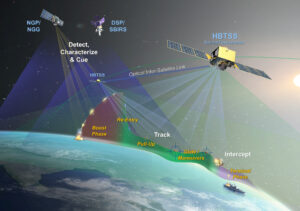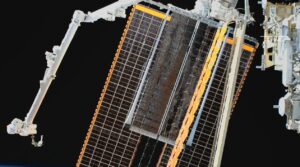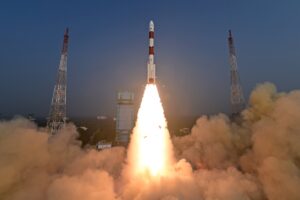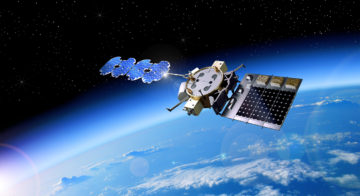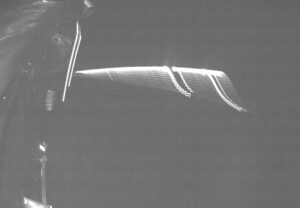HELSINKI — Japan’s SLIM “Moon Sniper” spacecraft made a successful lunar landing Friday, making the country just the fifth to robotically land on the moon.
The Smart Lander for Investigating Moon (SLIM) spacecraft began its descent from a 15-kilometer perilune shortly after 10:00 a.m. Eastern, Jan. 19 (1500 UTC), decelerating from a speed of around 1,700 meters per second.
SLIM appeared to have successfully touched down at 10:20 a.m. (1520 UTC), during a Japan Aerospace Exploration Agency (JAXA) livestream of the event. It was not however immediately clear if the landing was successful, with the livestream ending inconclusively. A wait of more than an hour followed for clarification and confirmation.
During the silence from JAXA, NASA’s Deep Space Network appeared to show signals from both SLIM and the Lunar Excursion Vehicle 1 (LEV-1)—a small rover accompanying SLIM and ejected onto the surface at an altitude of two meters—being received in Madrid. Amateur tracking stations meanwhile reported signals from both SLIM and LEV-1.
JAXA confirmed landing success during a press conference just under two hours after the landing occurred. However the spacecraft’s solar cells were not generating electricity. The reason for the solar cell issue was not immediately known, but spacecraft orientation—suggesting the lander may have rolled—is consider a possibility. SLIM is currently working on battery power.
“We believe that the soft landing itself was successful,” a JAXA official said, stating that the spacecraft had survived the landing and was sending data.
Teams are working to maximize data gathering and science output. LEV-1 and another rover, LEV-2, were also confirmed to have separated successfully and operating. JAXA will said it will hold another press conference in the following week.
Five crushable, 3D-printed aluminum lattice landing legs helped the lander absorb the impact of touchdown on the lunar surface.
The mission was primarily aiming to demonstrate precise landing technology, allowing the spacecraft to set down within 100 meters of a target point. SLIM was targeting a landing on the sloped rim inside the 300-meters-wide Shioli crater.
While the landing was confirmed successful, it will take up to a month to confirm the success or failure of the “pinpoint” landing. The accuracy will be assessed with observations from lunar orbit.
An accurate landing is not just an engineering feat, but one that could enable greater science returns.
“The SLIM mission, with its precision landing system, hopefully marks a more successful year of lunar landings by robotic explorers,” Katherine Joy, a Reader in Earth Sciences at the University of Manchester, told SpaceNews.
“Touching down in just the right spot is key to targeting really interesting lunar locations that can help us test key science questions about the evolution of the Moon and where we want to explore to assess possible lunar resources.”
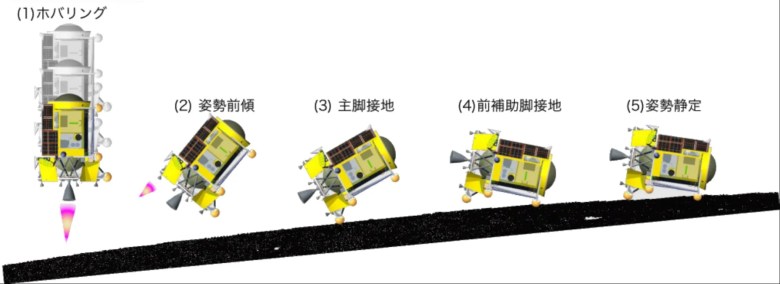
The landing comes just under five months after India became the fourth country to land on the moon with Chandrayaan-3. It also follows a day after Astrobotic’s Peregrine Mission One lunar lander reentered Earth’s atmosphere, with a propellant leak earlier scuppering plans for a lunar landing attempt.
It was not the first Japanese attempt to land on the moon. Tokyo-based private firm ispace aimed for a lunar landing in April 2023, but a software issue led to the loss of the HAKUTO-R M1 lunar lander. A new attempt using similar hardware with upgraded software is planned for later this year.
SLIM will spend the rest of the roughly 14-Earth-day-long lunar daytime on the moon carrying out science objectives. The spacecraft does not carry a radioisotope heater unit and is not expected to survive the lunar nighttime. During the lunar night temperatures will drop to around minus 130 Celsius.
The spacecraft’s Multi-Band Camera (MBC) will assess the composition of Shioli crater by analyzing the spectra of sunlight reflected off its surface. It will, in particular, be used to search for the presence of olivine, a mineral which may have been ejected from beneath the moon’s crust.
“Shioli impact crater, found in the nearside central highlands of the Moon, is a very small impact crater,” Joy notes. “The crater in itself is not that different from millions of other small craters on the Moon. However, it is located on the ejecta blanket of a much larger, roughly 100 km diameter, impact crater called Theophilus and so it might sample rocks and minerals that were excavated from deeper horizons within the lunar crust.”
SLIM also carried a pair of small, innovative rovers with it to the moon. Lunar Excursion Vehicle 1 (LEV-1) uses a hopping mechanism, while LEV-2 is a baseball-sized, spherical rover. Both carry cameras and science payloads.
SLIM launched Sept. 6, 2023, and completed a looping, 110-day voyage to the moon Dec. 25, when the spacecraft entered lunar orbit. The flight profile saved the spacecraft propellant and allowed for a higher science payload mass.
The spacecraft trimmed its orbit to a circular, 600-kilometer polar orbit Jan. 14 in preparation for the landing attempt.
SLIM is one of a number of 2024 lunar landing attempts, along with Peregrine Mission One. China is gearing up for an unprecedented lunar far side sample return mission around May. U.S. firm Intuitive Machines is planning up to three landings. The first, IM-1, is currently scheduled to launch in February.
The wave of missions stems in part from a renewed interest in the moon, particularly surrounding the lunar south pole and potential sources of water-ice. It also coincides with growing international and commercial space capabilities and access to launch opportunities.
—
Edited at 12.51 p.m. Eastern, Jan. 19 to clarify issue of solar cell electricity generation to potentially be related to attitude of the lander.
- SEO Powered Content & PR Distribution. Get Amplified Today.
- PlatoData.Network Vertical Generative Ai. Empower Yourself. Access Here.
- PlatoAiStream. Web3 Intelligence. Knowledge Amplified. Access Here.
- PlatoESG. Carbon, CleanTech, Energy, Environment, Solar, Waste Management. Access Here.
- PlatoHealth. Biotech and Clinical Trials Intelligence. Access Here.
- Source: https://spacenews.com/japan-makes-history-with-tense-successful-moon-landing/
- :is
- :not
- :where
- ][p
- $UP
- 1
- 10
- 100
- 12
- 130
- 14
- 19
- 20
- 2023
- 2024
- 25
- 51
- 700
- a
- About
- access
- accuracy
- accurate
- Aerospace
- After
- agency
- Aiming
- allowed
- Allowing
- along
- also
- amateur
- an
- analyzing
- and
- Another
- appeared
- April
- ARE
- around
- assess
- assessed
- At
- Atmosphere
- attempt
- Attempts
- attitude
- battery
- BE
- became
- been
- began
- believe
- both
- but
- by
- called
- camera
- cameras
- CAN
- capabilities
- carried
- carry
- carrying
- cell
- Cells
- Celsius
- central
- China
- circular
- clear
- coincides
- comes
- commercial
- Completed
- composition
- Conference
- Confirm
- confirmation
- CONFIRMED
- Consider
- could
- country
- Currently
- data
- day
- dec
- deeper
- demonstrate
- different
- does
- down
- Drop
- during
- Earlier
- earth
- Earth sciences
- eastern
- electricity
- enable
- ending
- Engineering
- Event
- evolution
- expected
- exploration
- explore
- Explorers
- Failure
- far
- feat
- fifth
- Firm
- First
- five
- flight
- followed
- following
- follows
- For
- found
- Fourth
- Friday
- from
- gathering
- gearing
- generating
- generation
- greater
- Growing
- had
- Hardware
- Have
- help
- helped
- higher
- history
- hold
- Hopefully
- Horizons
- hour
- HOURS
- How
- However
- HTML
- HTTPS
- if
- immediately
- Impact
- in
- india
- innovative
- inside
- intends
- interest
- interesting
- International
- intuitive
- issue
- IT
- ITS
- itself
- Jan
- Japan
- Japan’s
- Japanese
- joy
- jpg
- just
- Key
- known
- Land
- landing
- larger
- later
- launch
- leak
- Led
- legs
- Livestream
- located
- locations
- loss
- Lunar
- lunar lander
- Machines
- made
- MAKES
- Making
- manchester
- Mass
- max-width
- Maximize
- May..
- MBC
- Meanwhile
- mechanism
- might
- millions
- mineral
- minerals
- Mission
- missions
- Month
- months
- Moon
- more
- much
- Nasa
- New
- night
- Notes
- number
- objectives
- observations
- occurred
- of
- off
- official
- on
- ONE
- operating
- opportunities
- or
- Orbit
- Other
- out
- output
- pair
- part
- particular
- particularly
- per
- planned
- planning
- plans
- plato
- Plato Data Intelligence
- PlatoData
- Point
- polar
- possibility
- possible
- potential
- potentially
- power
- precise
- Precision
- preparation
- presence
- press
- primarily
- private
- Profile
- Questions
- Reader
- really
- reason
- received
- reflected
- related
- renewed
- Reported
- Resources
- REST
- returns
- right
- roughly
- rover
- s
- Said
- saved
- scheduled
- Science
- SCIENCES
- Search
- Second
- sending
- set
- Shortly
- show
- showing
- side
- signals
- Silence
- similar
- small
- smart
- So
- Soft
- Software
- solar
- Solar cells
- Sources
- South
- Space
- spacecraft
- speed
- spend
- Spot
- stating
- Stations
- stems
- success
- successful
- Successfully
- sunlight
- Surface
- Surrounding
- survive
- Survived
- system
- Take
- Target
- targeting
- Technology
- test
- than
- that
- The
- this
- this year
- three
- to
- told
- touched
- Tracking
- two
- u.s.
- under
- unit
- university
- unprecedented
- upgraded
- us
- used
- uses
- using
- UTC
- vehicle
- very
- Voyage
- wait
- want
- was
- Wave
- we
- week
- were
- when
- which
- while
- will
- with
- within
- working
- year
- youtube
- zephyrnet

